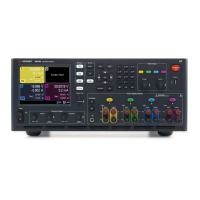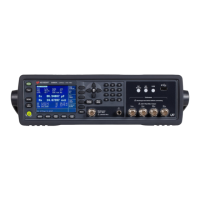Page 17
Find us at www.keysight.com
Test port 3
C
R3
Test port 1
R1
Test port 4
R4
Test port 2
R2
35 dB
65 dB
35 dB
65 dB 65 dB
35
dB
65 dB
A
35 dB
D B
Source 2
OUT 1OUT 2
Pulse
modulator
Source 1
OUT 1OUT 2
Pulse
modulator
Pulse generators
To receivers
LO
RABCD
IF inputs
Rear panel
1. The block diagrams shown above include hardware that must be ordered
as separate options, such as pulse modulators (Options 021 and 022),
and IF access (Option 020), or is controlled by application software, as
is the case for the pulse generators. In addition, the combiner type and
attenuator values vary by model number. Refer to the product data sheet
for the correct block diagram for a specific model.
4-ports, dual source, with extended power range
(Option 417)
This configuration comes with two sources, front-panel
access loops, and source and receiver attenuators at each
port. The source attenuators are settable in 5 dB steps up
to 65 dB in N5221/22B, and in 10 dB steps up to 60 dB in
N5224/25B. The receiver attenuators are settable in 5 dB
steps up to 35 dB. The maximum power rating on the test
port couplers is +43 dBm (additional attenuators or isolators
are typically required to protect other components inside the
instrument). Option 417 is not available on the N5227B. To
independently control the frequency of the second internal
source, one of the following software applications is required:
S93080/029/082/083/084/086/087/089/090x/093/094B/A.
4-ports, dual source, and low-frequency
extension (Option 405)
Along with the two sources, 12 front-panel access loops and
R1 reference-receiver switch of option 401, Option 405 adds
additional hardware to extend the start frequency of the PNA
down to 900 Hz. The extended start frequency is available
only for the following measurement classes: standard, gain
compression (amplifier and converters), and for magnitude-
only measurements using SMC (scalar mixer/converter) or
SMC+Phase. In the standard channel, pulsed RF, true-mode
stimulus, and source phase control are not supported for
measurements below 10 MHz. The block diagram below shows
how the low-frequency hardware is configured for one test port;
the other test ports are configured similarly.
PNA Series Test Set and Power Configuration Options
1
(Continued)
Standard source
10 MHz - 8.5/13.5/26.5/43.5/50/67.5 GHz
Pulse modulator
R1
A
Test
port
A'
LF source
900 Hz - 100 MHz
R1'
External bias
Test port 3
C
R3
Test port 1
R1
Test port 4
R4
Test port 2
R2
A D B
Source 2
OUT 1OUT 2
Pulse
modulator
Source 1
OUT 1OUT 2
Pulse
modulator
Pulse generators
To receivers
LO
RABCD
IF inputs
Rear panel
4-ports, dual source, with configurable test set
(Option 401)
The 4-port configurable test set comes with two internal
sources, and twelve front-panel access loops. The loops provide
access to the signal path between (a) the source output and the
reference receiver, (b) the source output and directional coupler
thru arm and (c) the coupled arm of the directional coupler
and the port receiver at all ports. Also included is a solid-state
internal RF bypass switch in the R1 reference-receiver path.
To independently control the frequency of the second internal
source, one of the following software applications is required:
S93080/029/082/083/084/086/087/089/090x/093/094B/A.

